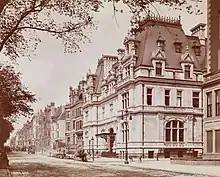Mrs. William B. Astor House
The Mrs. William B. Astor House was a mansion on Fifth Avenue in the Upper East Side neighborhood of Manhattan, New York City. It was located at 840 and 841 Fifth Avenue, on the northeast corner of 65th Street, completed in 1896 and demolished around 1926.

.jpg.webp)
History
The house was originally built as a double mansion for Caroline Schermerhorn Astor, the widow of real estate heir William Backhouse Astor Jr., and her son John Jacob Astor IV. Construction started in 1894, and the house would transpire to be the largest of its kind on Fifth Avenue.
Caroline Astor lived in the northern half of the mansion (841 Fifth Avenue), while her son and his family lived in the southern half (840 Fifth Avenue). After Caroline Astor died in 1908, her son converted the double mansion into a single home for his family.
The mansion was designed by Richard Morris Hunt, who used the early French Renaissance architecture from the period Louis XII and Francois I, style similar to a château and the French Louis XII Style (in French), revival of the Château de Blois.
The house was the setting for many parties and was a New York City attraction. The ballroom could hold 1,200 people, compared with 400[1] at her previous mansion at 350 Fifth Avenue and 34th Street.
The mansion was sold to real estate developer Benjamin Winter Sr.[2] and demolished around 1926. Today, the temple of the Congregation Emanu-El of New York is located on the site.
Architecture

.jpg.webp)
Ground floor
One entered the front of the house into a domed vestibule, from which one could proceed through a hall lined with busts of Caroline's ancestors to the marble great hall, where a huge and handsome marble staircase led upstairs. From the great hall, guests would enter the Adam style reception room, where they were greeted by Caroline, decked in jewels, under her portrait by Carolus-Duran. At the end of the great hall was the entrance, flanked by two large vases and gold satin curtains, to the ballroom.
From the great hall, led the gold-ceilinged drawing room, the walls of which were covered with gold-framed mirrors and the floor of which was covered with oriental rugs, tiger rugs, leopard rugs, and several rugs woven out of feathers.
One could also enter the dining room, the black marble walls of which were covered with tapestries depicting hunting scenes, and whose black-and-white marble-tiled floors were covered with polar-bear rugs, all centered on the marble stoned fireplace with mantle crowded with vases, and a huge crystal chandelier also hung with satin draperies.
From the dining room, was the breakfast room, which contained Caroline's tea-cup collection. The room also had a small table covered with a red-and-white tablecloth and a small oriental vase filled with flowers.
Ballroom
The ballroom was the largest room of the house, spanning the entire rear of the house and rising four stories to the roof. The ballroom doubled as the art gallery; the satin-paneled walls were hung with Mrs. Astor's famed art collection, while the parquet floors were covered with four massive red oriental rugs and 16 long narrow red Persian rugs. Also dotted around the floor were colorful peacock feathered woven rugs.
From the ceiling were suspended four large crystal chandeliers, each with several pearl strings linking from one to the other. At one end of the ballroom was a massive floor to ceiling marble chimney piece; this featured two sculptures of male nudes supporting a painted panel of a gala at the palace of Versailles. At the other end was a minstrel’ gallery opening from the second floor, where a wall of Chinese screens blocked the musician's view of the ballroom. In front of the balcony was Mrs. Astor's statue of Venus; around it were several potted plants and a small marble waterfall. Before the fireplace stood two the Louis XVI candelabra that her dead husband William had bought in Europe. In between the candelabra was a raised dais covered in fur blankets, on top of which was a red satin divan, upon which Caroline would sit. In between the divan were two small tables, on top of which were two marble horse heads. In the middle of the ballroom was Mrs. Astor's red velvet plush round ottoman with a round back in the middle and a huge marble vase at the top. Also along the walls and in the center of the room were several plush red velvet couches, lounge chairs and chairs.
Second floor
On the second floor was Caroline's bedroom, domed boudoir, dressing room, bathroom, closets and her pink sitting room. also on this floor was a guest suite and the linen closet.
The remaining floors contained numerous guest rooms and servants rooms.
Further reading
- Kathrens, Michael C. (2005). Great Houses of New York, 1880-1930. New York: Acanthus Press. p. 71. ISBN 978-0-926494-34-3.
- Architectural blog
References
- Parker, Maggie. "The Four Hundred: Then and Now Tony Abrams has reinvented Gilded Age society. Will you get in?". Dujour. Retrieved September 22, 2018.
- Miller, Donald L. Supreme City: How Jazz Age Manhattan Gave Birth to Modern America
External links
| Wikimedia Commons has media related to Mrs. William B. Astor House. |
- The Lost John Jacob Astor Mansion at 840 Fifth Avenue – Daytonian in Manhattan
- The Astor Double Mansion on Fifth Avenue – The Gilded Age Era
- Astor Mansion At 65th Street – The Gilded Age Era